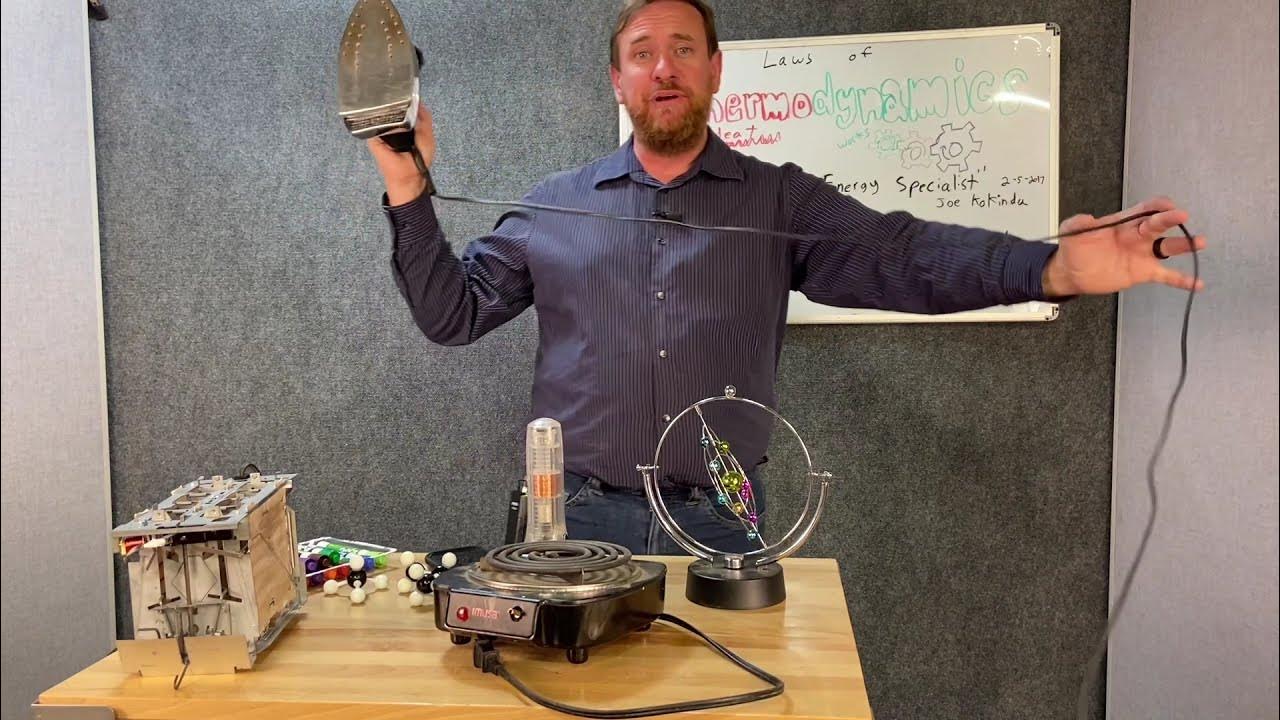PRIMERA LEY DE LA TERMODINÁMICA
Summary
TLDRThis video explains the first law of thermodynamics, which states that energy cannot be created or destroyed, only transformed. It explores the concept of internal energy, including kinetic, potential, and thermal energy, and how they contribute to a system's total energy. Real-world examples such as hydroelectric power generation and hand friction are used to illustrate energy transformation. The video also delves into the mathematical applications of the law, explaining how to calculate changes in internal energy, heat, and work, with detailed problem-solving exercises to reinforce understanding of thermodynamic principles.
Takeaways
- 😀 The First Law of Thermodynamics states that energy cannot be created or destroyed, only transformed. It remains constant within a closed system.
- 😀 Internal energy refers to the total energy within a system, including kinetic, potential, and heat energy from particles in motion.
- 😀 The law connects work and heat exchange in a system with a new thermodynamic variable: internal energy.
- 😀 Examples of energy transformation include how hydroelectric dams convert kinetic energy from water into electrical energy, which is then transformed into heat energy for use in homes.
- 😀 Rubbing your hands together in cold weather generates heat due to the friction between them, demonstrating the conversion of kinetic energy into heat.
- 😀 Work in thermodynamics is defined as the transfer of energy through the application of force, such as the movement of a piston in an engine.
- 😀 The First Law of Thermodynamics is expressed in terms of heat (Q), work (W), and the change in internal energy (ΔU). These variables help calculate energy changes in systems.
- 😀 Heat absorbed by a system is positive, while heat ceded by the system is negative. Similarly, work done by the system is positive, and work done on the system is negative.
- 😀 When solving problems, units of energy are often in joules, and conversions may be necessary (e.g., converting calories to joules using the factor 1 calorie = 4.184 joules).
- 😀 Practical exercises include calculating the change in internal energy based on given values of heat absorbed or released and work done, following the equation ΔU = Q - W.
Q & A
What is the first law of thermodynamics?
-The first law of thermodynamics states that the total energy of an isolated system remains constant; energy is neither created nor destroyed, but it transforms from one form to another.
What are the three types of energy mentioned in the video?
-The three types of energy mentioned are kinetic energy, potential energy, and heat energy (thermal energy).
How does internal energy relate to the particles within a system?
-Internal energy refers to the total energy of the particles within a system, including their kinetic energy (motion), potential energy, and thermal energy.
How does the video explain the concept of hydroelectric power in relation to thermodynamics?
-The video explains that in hydroelectric plants, water descends, converting its potential energy into kinetic energy. This kinetic energy then spins turbines that generate electrical energy, showcasing the transformation of energy as described in the first law of thermodynamics.
What does friction between your hands demonstrate in terms of thermodynamics?
-The friction between your hands, when rubbed together, generates thermal energy (heat), demonstrating the transformation of mechanical energy into heat energy as described by the first law of thermodynamics.
What is work in the context of thermodynamics?
-In thermodynamics, work refers to the transfer of energy due to a force applied to a system, leading to a displacement or change in the system’s state.
How does a piston work in a thermodynamic system?
-A piston works by using heat energy to expand a gas inside a cylinder. This expansion causes the gas to perform work, moving the piston, which converts thermal energy into mechanical work.
What is the significance of heat (q) in thermodynamics?
-Heat (q) in thermodynamics represents the energy exchanged between a system and its surroundings due to temperature difference. Heat is positive when absorbed by the system and negative when ceded by the system.
How do you calculate the change in internal energy using heat and work?
-The change in internal energy (ΔU) can be calculated using the equation ΔU = q - W, where q is the heat exchanged and W is the work done. If heat is absorbed, q is positive; if heat is ceded, q is negative. If work is done by the system, W is positive, and if work is done on the system, W is negative.
In the provided example, what is the change in internal energy if 700 calories of heat are added and 900 joules of work are done on the system?
-First, convert 700 calories to joules: 700 * 4.18 = 2,926 joules. Then, apply the formula ΔU = q - W: ΔU = 2,926 J - (-900 J) = 3,826 J. The change in internal energy is 13,826 joules.
Outlines

Dieser Bereich ist nur für Premium-Benutzer verfügbar. Bitte führen Sie ein Upgrade durch, um auf diesen Abschnitt zuzugreifen.
Upgrade durchführenMindmap

Dieser Bereich ist nur für Premium-Benutzer verfügbar. Bitte führen Sie ein Upgrade durch, um auf diesen Abschnitt zuzugreifen.
Upgrade durchführenKeywords

Dieser Bereich ist nur für Premium-Benutzer verfügbar. Bitte führen Sie ein Upgrade durch, um auf diesen Abschnitt zuzugreifen.
Upgrade durchführenHighlights

Dieser Bereich ist nur für Premium-Benutzer verfügbar. Bitte führen Sie ein Upgrade durch, um auf diesen Abschnitt zuzugreifen.
Upgrade durchführenTranscripts

Dieser Bereich ist nur für Premium-Benutzer verfügbar. Bitte führen Sie ein Upgrade durch, um auf diesen Abschnitt zuzugreifen.
Upgrade durchführenWeitere ähnliche Videos ansehen

The Law of Conservation of Energy

HVAC 003 1st Law of Thermodynamics

First Law of Thermodynamics introduction | Biology | Khan Academy

A Primeira Lei da Termodinâmica Explicada

Praktikum Sederhana Hukum 1 Termodinamika | Mengapa Balon Yang Berisi Air Dipanaskan Tidak Meletus?

Work Power and Energy by Science Matters for Grade 8 Science
5.0 / 5 (0 votes)
